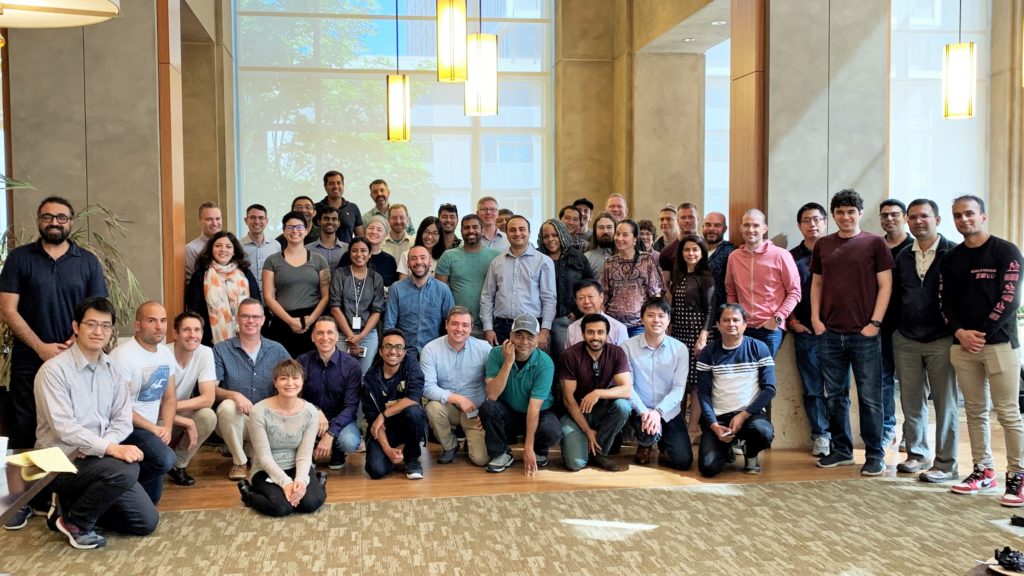
(Our Bay Area Autonomous Systems team together with their Redmond counterparts at Hackathon 2019)
Make an impact is the mantra of our Bay Area Autonomous Systems group.
The local team is helping build a platform that abstracts low-level mechanics of machine learning so subject matter experts—regardless of how much AI experience they have—can train machines to do complex tasks. The progress they’re making is moving us beyond automation, and into autonomous systems.
The difference is drastic. Imagine a manufacturing company wants to train a machine to autonomously calibrate a critical piece of equipment, constantly in need of repair due to varying temperatures and humidity. The mechanic would create a “lesson plan” that outlines relevant information to perform the task and monitor system performance. They would then train the machine to recognize discrepancies and how to adjust when needed. Not only will this model increase efficiency, but it also helps keeps the mechanic safe by not putting them at risk while repairing the machine.
This is the type of real-world problem our team is trying to solve. And to do it, they are training AI systems differently.
Machine teaching vs machine learning
There is a learning curve for everyone. The idea of machine teaching is no different.
To teach a six-year old to hit a ball you start with a large whiffle ball on a tee. When they get good at hitting that, you throw the whiffle ball underhand slowly. After they master that, you slowly increase the speed and hardness of the ball. “This is very natural in human terms, but completely foreign when you try and train applied machinery,” says Mark Hammond, general manager of Business AI. “Everyone is throwing a fast ball at these machines. We are taking a different approach.”
This is called reinforcement learning. Subject matter experts who can easily break down a problem are critical. They are needed to tell a machine what is important at the outset, what actions are acceptable, and what are proper reactions. The machine learning model is then created in a digital, test environment. This expedites the learning process, because in a digital environment countless tests can be performed that reward a machine based on how close its action is to perfect.

(Table showing key aspects of programming machine teaching on the platform and where each is programmed)
Real world application
Reinforcement learning is not new. There have been large strides forward, particularly in areas like gaming where computers have beaten human players in games like Go and DOTA. However, moving from the simulator and into the real world is a challenge yet to be solved.
It means engineers on the team must come to terms with integrating their work with the physical world. “The physical world has friction, it has wear and tear, and entropy,” says Scott Stanfield, a principal PM in Autonomous Systems. “Software fits into a nice box in a lab or chart on a screen. But if we want to apply software techniques to the world and have an impact on major issues like climate change, we have to adapt to different environments.”
This challenge means a diverse and eclectic team. Physicists. Mechanical engineers. Artificial intelligence gurus. Machine learning experts. Chemical and electrical engineers. PhDs in control theory. “We’re working in a cross-disciplinary team to the utmost degree. To pull off what we’re trying to do takes a big team, and a big company,” says Stanfield, who says the environment is “extraordinarily exhilarating.”
If you want to be working on the latest algorithms in a lab, it isn’t the team for you. “But if you want to take those algorithms and put them into real-world applications, we’re absolutely the best place in the world to be, right now,” says Hammond.
Scaling for impact
Formerly known as Bonsai, this team is literally scaling to make an impact. The collective tools, resources, and researchers that Microsoft has provided after the acquisition has been a tremendous advantage. As to what it feels like being part of Microsoft, Hilary Burgess, an executive assistant on the team says, “It’s really inspiring to be working with such talented people. Microsoft is like a really well-run machine. It’s huge, and suddenly your reach is so much farther than it was.”
The culture remains as adventurous, open-minded—and passionate about changing the world —as before. “We’re sitting two blocks away from UC Berkeley, and we have very strong ties,” says Mark Hammond. In fact, the team has a close working relationship to the Berkeley lab which is working on RLlib, an open-source library for reinforcement learning. “We attend their weekend planning sessions, and literally have a seat at the table to help drive the work forward,” says Hammond.
This new approach to AI attracts people who are always pushing themselves to learn more. The special sauce is that they also have a “moral imperative” to create something that will have a long-lasting impact on the world, says Stanfield.
Make a difference
To get a more detailed look into what the group is doing in the field of robotics and autonomous systems, go to Microsoft’s autonomous systems page.
“If you want to have an impact, and have your work actually touch people, join us,” says Stanfield. “There’s an entrepreneurial spirit that drives us to learning about what really matters. Together we’re looking at the best way to apply technology to solve problems not only for business, but for human potential.”
If you are interested in joining the team, open roles can be found here on the Microsoft Bay Area job page: https://aka.ms/MicrosoftBayAreaCareers



